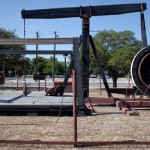Where Things Stand on the Keystone XL Pipeline

Photo by Mladen Antonov/AFP/Getty Images)
A protester demonstrates against the pipeline in front of the White House last summer.
There are just weeks left before a deadline for the Obama administration to make a decision on the controversial Keystone XL pipeline, a $7 billion, 1,700-mile project that would bring 700,000 barrels of oil a day from the Alberta oil sand fields in Canada to refineries in Texas.
UPDATE: Politico is reporting that the Obama administration will “formally reject permit for Keystone XL pipeline.” An official announcement is expected this afternoon. We will be reporting more as things develop.
More from the Washington Post:
“However the administration will allow TransCanada to reapply after it develops an alternate route through the sensitive habitat of Nebraska’s Sandhills. Deputy Secretary of State William J. Burns will make the announcement, which comes in response to a congressionally-mandated deadline of Feb. 21 for action on the proposed Keystone pipeline.”
So where do things stand right now? Essentially, in limbo. The company behind the pipeline, TransCanada is busy trying to find an alternate route through Nebraska, where the route stalled after state legislators expressed concern about the impact on environmentally-sensitive areas in the pipeline’s path. (Read the background here in our Keystone XL Explainer.)
Today NPR reports that even if the Canada-to-Texas pipeline doesn’t go forward, the oil sands crude will still find a way to the market:
“Philip Verleger, an economist who specializes in oil markets, says even if environmentalists convince Obama to block the Keystone XL pipeline, it won’t stop the growth of production in the Canadian oil sands.
“With prices around a hundred dollars a barrel globally, that oil is going to make it to the market somehow,” Verleger says. “The development may be slowed for a year or two. But one can move the oil west on the existing Kinder Morgan pipeline. They could expand pipelines east. Those pipelines already exist, and they can be expanded.””
In November, StateImpact Texas’ Mose Buchele spoke with William Fisher, a professor at the Jackson School of Geo Science, at the University of Texas at Austin. He was asked if the delay meant an end to the oil sands crude coming to Texas.
“No, it does not! Not with oil at prices we’re likely to see at $80 to $100 a barrel. This is quite economic, that’s why it’s likely to move forward,” told StateImpact Texas at the time. More from our previous report:
“Fisher adds that tar sands oil is of the dirty, heavy hard-to refine variety. That’s one of the reasons it’s disliked so much by environmental groups. But it’s also exactly the kind of oil Texas is good at refining. Texas refineries processed heavy Mexican and Venezuelan oil. But, recently, those supplies began dwindling.
“With those going down, the Canadians would match up very nicely with that refining capacity for heavy oil,” said Fisher.”
One issue that environmental groups have latched on to in opposition to the pipeline is the potential corrosive effects of the crude being extracted from the oil sands of Canada. The “oil” being extracted is technically bitumen, a mixture of clay, sand, water, and oil that with modern technology can be refined into usable oil. Environmentalists say the process of refining tar sand will create large amounts of greenhouse gas emissions, and that bitumen may be more corrosive to the pipelines than your typical crude. Reuters has more:
A study done last year for the provincial government of Alberta, home to Canada’s oil sands, found diluted bitumen was no more corrosive to pipelines than conventional oil, but noted there was no definitive peer-reviewed research on the issue.
President Barack Obama signed a new pipeline safety law earlier this month containing a little-noticed provision for a study on diluted bitumen that may answer some of the questions. The provision mandates the Pipeline and Hazardous Materials Safety Administration (PHMSA) to analyze the risks of the oil, review its regulations, and present its results to Congress in the next 18 months.
And the political football that is the pipeline is still being tossed back and forth. House Speaker John Boehner (R-Ohio), who has been a vocal proponent of the pipeline (and forced the decision deadline on the Obama administration as part of a deal before the holidays to extend tax cuts), has begun what amounts to a campaign to pass the pipeline deal. The Washington Post reports that Boehner has “launched a “countdown clock” that ticks off the time until the permitting deadline expires,” the paper writes, “and posted a video on YouTube that touts the pipeline as a chance to create jobs with private investment.”
Here’s that video:
There’s a potential conflict of interest, however. As the Post reports, Boehner is also an investor in the pipeline:
“Environmentalists note that in December 2010, according to Boehner’s financial disclosure forms, he invested $10,000 to $50,000 each in seven firms that had a stake in Canada’s oil sands, the region that produces the oil the pipeline would transport. The firms include six oil companies — BP, Canadian Natural Resources, Chevron, Conoco Phillips, Devon Energy and Exxon — along with Emerson Electric, which has a contract to provide the digital automation for the first phase of a $9.4 billion Horizon Oil Sands Project in Canada.
Boehner spokesman Michael Steel said in an interview that an investment adviser chooses Boehner’s financial investments. “He doesn’t have any control over day-to-day trades, so there’s no conflict of interest on this or any other investment.””



